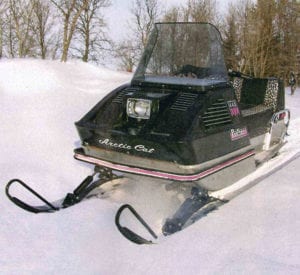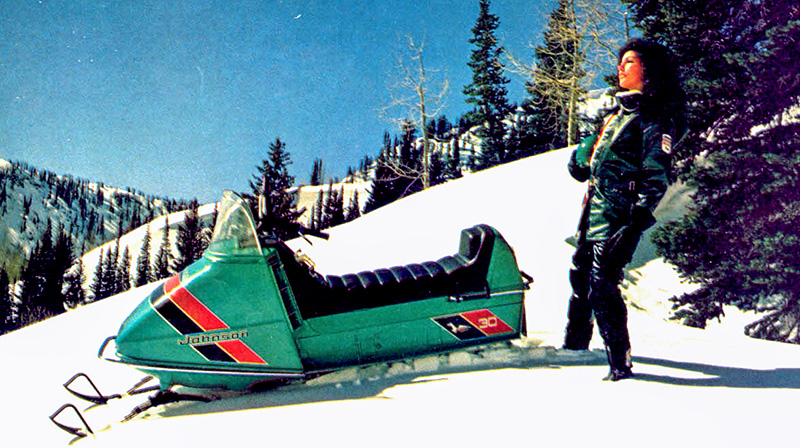
At 3:30 p.m. on Thursday, December 2, 1971, Arctic Enterprises Inc. (AEI) completed building its 100,000th snowmobile for model year 1972 – a Panther 440 – marking the first time that an American manufacturer had reached that number of sleds built for a single season. A few weeks earlier, Minnesota Senator Hubert Humphrey had presented a 1972 Panther 399 to Anatoly Dobrynin, Soviet Ambassador to the U.S., after the Russian diplomat expressed interest in trying snowmobiling.
It was no accident that the Panther was selected for both of these notable events. The big, black, slide-rail sedan had been Arctic Cat’s best seller ever since the model’s first full season in 1967, and the company was riding it to the top of the booming snowmobile industry.
AEI built and sold almost 52,000 Panthers for the 1972 season, more than all models combined from any of its competitors other than Bombardier, making it perhaps the top single-season production model of all time that wasn’t yellow.
They also called the big Cat “The Boss,” and with good reason.
The Boss Gets Better
A transitional model from Cat’s multi-engine supplier past to a new era dominated by Kawasaki power, the 1972 Panther was offered with a choice of six different engines.
Production quantities ranged from 451 of the gutless, 8 HP, Kohler four-cycle model that wasn’t even mentioned in the sales literature, to about 10,000 with the popular Sachs 303 Wankel rotary engine and to about 16,600 of the best seller with a Kawasaki 440 axial fan twin. Other Kawasaki engines were a 292 single that kept a two-stroke Panther below the magic $1,000 price point, plus 340 and 399 axial fan two cylinder models that featured many interchangeable parts with the 440.
The Kawasaki engines were easier to pull start than most of their competition, though electric start was a dealer-installed option for any of them, but not on Wankel or Kohler-powered machines. One hundred of the 440s were built with polyurethane tracks instead of the usual cleated tracks, and a very few test units were made featuring the Kawasaki Cat-O–Matic fluid transmission that would later appear in the Panther VIP.
Restyled for 1972, this was the last year for an open-backed hood as newly mandated sound regulations pushed manufacturers to utilize air boxes and fully enclosed hoods with sound-deadening foam for 1973. In addition to increasing sled weights and decreasing carb access, this change made virtually all 1973 snowmobiles of any brand – especially those with diaphragm pumper carbs – more susceptible to immobilizing vapor lock, so the ’72s were definitely more reliable, if slightly louder, than ’73 models.
Increasing safety emphasis on all the 1972 Cats saw the addition of kink- and freeze-resistant throttle and brake cables, a more convenient handlebar-mounted kill switch to replace the old console-mounted switch, padded handlebar and reflective front bumper trim. Shocks in the front and rear suspensions were standard when many competitors still provided them only as extra-cost options – if they were available at all. With the gas tank still in the seat back, there was plenty of room for a new console-mounted tool box to provide storage for trail necessities, but the latch didn’t work very well.
One thing that didn’t really change much was Arctic Cat’s patented slide rail suspension that was tweaked a bit for ‘72 to better shed packed-in ice and show. “As usual, Arctic will give you the best ride in the business,” Snow Goer reviewers concluded. “In our estimation, their suspension system hasn’t been matched by anyone yet.“

Editors also praised other details. “The console is slick, the (partial snow-leopard print) seat is striking and comfortable, and good design is apparent in most features.”
On a personal note, I rode three different 1972 Panthers – a 303 Wankel, a 3 99 and a 440 Cat-O-Matic – that winter.
They were vastly superior to most of the competitive two-seaters that I had tried in terms of ergonomics and comfort, handling, reliability and just about any other criteria for comparison other than maybe top speed. The ’72 Panthers were so far ahead of the rest that it just didn’t matter who was next best.
Panther Perspective
Looking back, 1972 was a benchmark year for snowmobiling. The winter was long and snowy. Snowmobile clubs were springing up all across the Snowbelt, and the North American snow trail network was beginning to coalesce into existence. Total industry production peaked out at around a half-million sleds – a number never to be approached again.
And at the heart of it all was the 1972 Panther, representing one of every 10 new sleds built that season despite competing with more than 100 other brands. More importantly, most of those Panthers were sold at retail while many thousands of other brands’ snowmobiles went unsold. Pretty impressive stuff.
Editor’s Note: Every issue of Snow Goer magazine includes in-depth sled reports and comparisons, aftermarket gear and accessories reviews, riding destination articles, do-it-yourself repair information, snowmobile technology and more! Subscribe to Snow Goer now to receive issues delivered to your door 6 times per year for a low cost.







My family has what we believe is the 100,000th arctic-cat panther 440 produced December 2, 1971
Is there any information out there for verification, perhaps documentation for a Vin number?
Any need help would be greatly appreciated
Lowell Swenson helmed Arctic Enterprises in those years
(Thief River Falls, MN).
Some company archives (physical paper files) or
electronic scans were hopefully transferred to
Textron, or perhaps an interested ex-employee.
Dad worked for Kawasaki in those years and was
the main guy working with Swensen on the engine
deal. I have photos of Swensen and his wife as
tourists in Japan to prove it 🙂
But sorry, no paper files on Arctic in our files.
At home, on Greenleaf Dr. south of Minneapolis
we kept an ‘expensed’ stable of Arctic cats during
those days.
(1971-1972 vintage) including a Panther, Puma,
Kitty-Cat, Cutter and even an early PROTOTYPE
of the later Panther VIP (Hydraulic transmission).
along with an Arctic Cat Minibike.
Yes, I was a corporate Brat and loving it.
Jeff@GizzMoVest.com
https://www.linkedin.com/pulse/business-development-build-race-car-consultant-vp-jeff-krause/